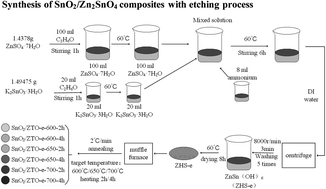Etching process enhanced H2O2 sensing performance of SnO2/Zn2SnO4 with reliable anti-humidity ability†
Abstract
In this work, sol–gel and chemical etching methods are adopted to synthesize zinc hydroxystannate materials. Cubic tin dioxide and zinc stannate composite materials with a definite structure are successfully prepared at varied annealing temperatures and times by using the synthesized zinc hydroxystannate as a sacrificial template. After a gas sensing test, tin dioxide and zinc stannate composite samples etched at 650 °C and annealed for 4 h exhibit a strong response and outstanding selectivity to hydrogen peroxide. Furthermore, the samples prepared under such conditions demonstrate long-term stability, and also a specified level of tolerance after the humidity stability test. Moreover, because of the simple preparation method and rapid detection of hydrogen peroxide, it is worth noting that samples prepared following the etching process at the 650 °C annealing temperature for 4 h exhibit the significant benefits of tin dioxide and zinc stannate composites. In this modern era, this research emphasizes the sample's potential for the rapid identification and detection of hydrogen peroxide.



 Please wait while we load your content...
Please wait while we load your content...